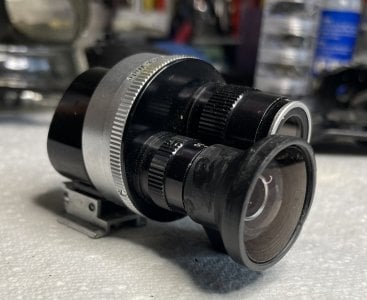wes loder
Photographer/Historian
Today, 50-35 may be the preferred focal lengths for RF 35s, but in the 1950s, the most popular auxiliary focal lengths were 135 and 90. A preference easily confirmed by an examination of lens sales during that period. If the camera already has a 50mm VF built in and often a 35 as well, why bother with a finder of such limited coverage? Yes—with an adapter—the coverage could be extended out to wider focal lengths, but hardly convenient. The Nikon zoom finder with coverage from 135 to 35 was a lot more practical, was smaller and easier to use.35 and 50 were (and are) widely-used focal lengths on 35mm RF cameras, so combining them let the photographer switch quickly without having to change (or carry) separate finders. As to “that's fine IF you are using a Canon finder”… uh, that was probably the whole point, dontcha think? Getting people who used accessory finders to use the Canon ones?
hilltime
Well-known
Try the late Black version of the 85/1.9, much lighter and a beautiful lens, as the 85/1.8 has become very $$$.
ranger9
Well-known
Presumably you've used all those options (as I have) so which provides the best viewing experience? The 35mm mode of Canon's built-in turret finder is small, blurry at the edges, and has no parallax compensation. Both the Nikon and Tewe zoom finders have similar viewing issues, and their parallax compensation is manual and dodgy. For Canon users who really cared about 35mm and 50mm viewing clarity and precision, Canon's finder was clearly (no pun intended) the best answer. Of course there never were a lot of those people, which is why this is a rare finder today.Today, 50-35 may be the preferred focal lengths for RF 35s, but in the 1950s, the most popular auxiliary focal lengths were 135 and 90. A preference easily confirmed by an examination of lens sales during that period. If the camera already has a 50mm VF built in and often a 35 as well, why bother with a finder of such limited coverage? Yes—with an adapter—the coverage could be extended out to wider focal lengths, but hardly convenient. The Nikon zoom finder with coverage from 135 to 35 was a lot more practical, was smaller and easier to use.
Bingley
Mentor
Yes, my Canon 85mm f1.9 comes from Peter K’s collection and was purchased directly from him. I used it to shoot a rock concert in 2021, but it’s a heavy beast. Optically, I think I prefer the Nikkor-PC 85mm f2.0 lenses in either S-mount or Contax rangefinder mount. And these lenses, although heavy, are not as brick like as the Canon. I think I’m set for 85mm rangefinder lenses at the moment, but I appreciate your recommendation. Who knows what may come up!!You should get a Canon 85/1.8 (my favorite lens in this focal length, even more than the 85/2 Sonnar). It weighs 470 grams, as compared to the chrome 85/1.9 that weighs 565 to 604 grams depending on the version according to Peter K's book. I just weighed my Nikkor 85/2 for Contax, it is 496 grams. I have the Canon 85/1.9 and agree that it is a heavy beast!
ACullen
Well-known
I'm looking for information about the Canon Lumi Finder 100mm (V type with parallax pin). I've just received a nice copy. I see that there are two sets of brighlines - a solid line rectangle and within that broken lines ( corners only). I'm wondering what the significance of these extra lines are given that the finder is one of the parallax correcting types. My guess is that they are for use at MFD . I can't see anything specific in the Canon literature I've found online.
I have the 135mm Canon finder. The inner set of lines would be for Field-of-View for the lens at minimum focus, the outer lines for infinity.
The finders are Parallax corrected. To indicate field-of-view for distance, a finder needs to have moving framelines. The Konica S2 and Polaroid Zeiss finders have viewfinders that are corrected for both Parallax and field-of-view. For example- the 90mm framelines on my Leica M9 are perfect for a Nikkor 10.5cm lens, just use the inner edge of the framelines at a distance > 6ft.
The finders are Parallax corrected. To indicate field-of-view for distance, a finder needs to have moving framelines. The Konica S2 and Polaroid Zeiss finders have viewfinders that are corrected for both Parallax and field-of-view. For example- the 90mm framelines on my Leica M9 are perfect for a Nikkor 10.5cm lens, just use the inner edge of the framelines at a distance > 6ft.
nhchen
Nathan
I bought on of those twin turret viewfinders recently. It was a lot brighter to look through than I had imagined it to be. I also didn’t realise that you needed an additional accessory lens for the accessory viewfinder to get the wider focal lengths. Seeing that it will probably be impossible to find the little lens I found a lens that seemed to work from my spare parts and 3D printed a mount for it to fit

dexdog
Mentor
nhchen, I think that you did pretty well recreating the scarce finder attachment. This is the Canon version. I found it 15+ years ago on eBay in a "big box of camera junk". The finder attachment is about 32mm front to back and about 35mm across the front. I dont know for sure, but I am guessing the attachment has three lens elements, based on counting reflections when observed under a strong light source




Last edited:
Share:
-
This site uses cookies to help personalise content, tailor your experience and to keep you logged in if you register.
By continuing to use this site, you are consenting to our use of cookies.

